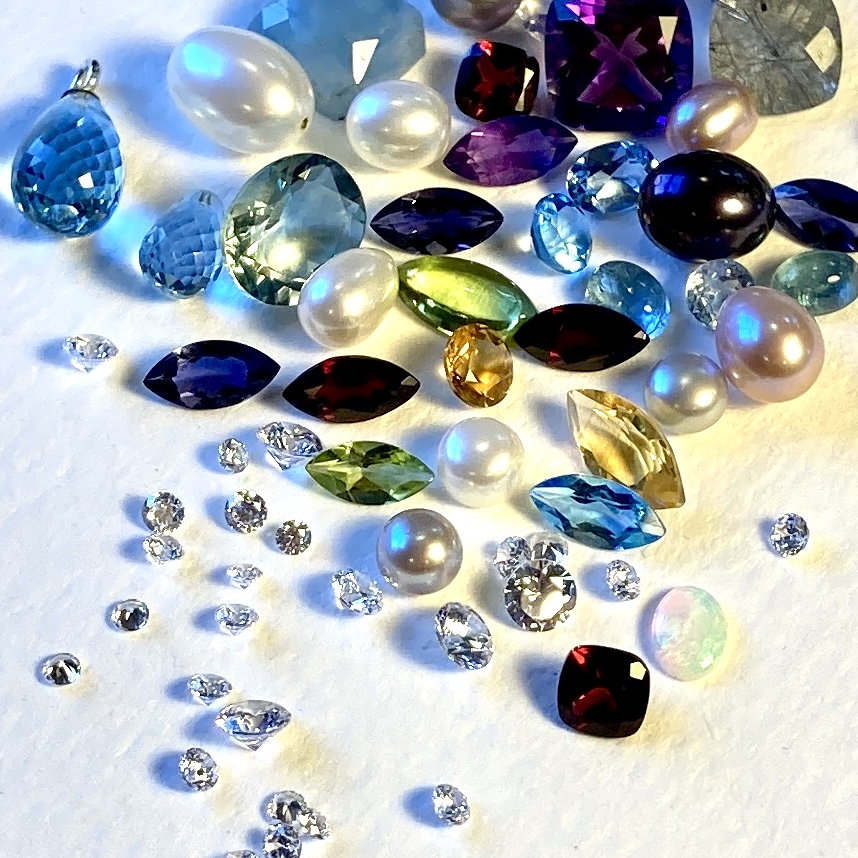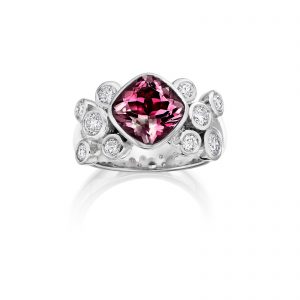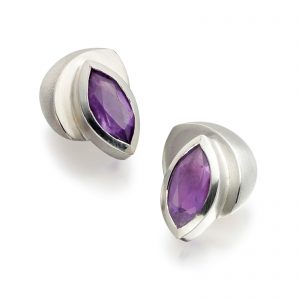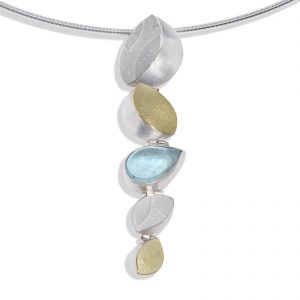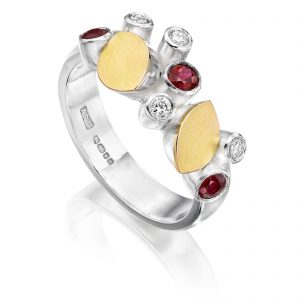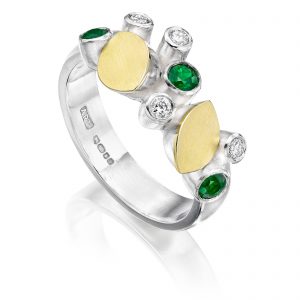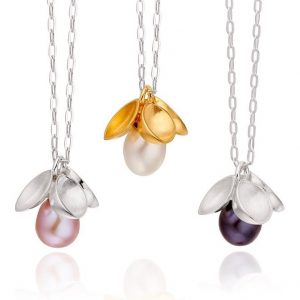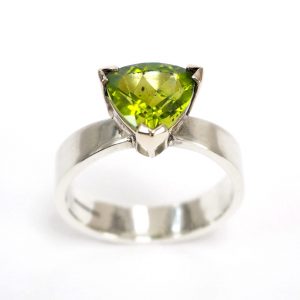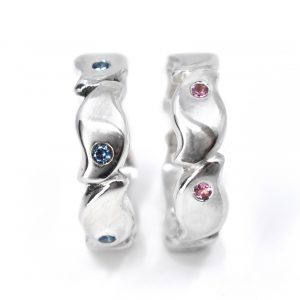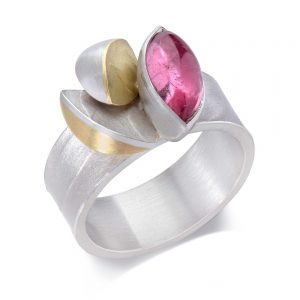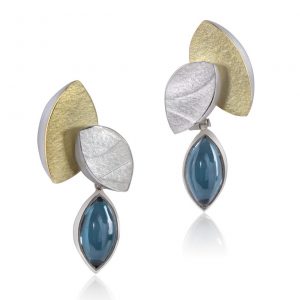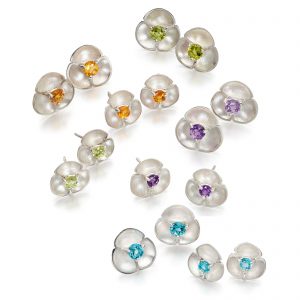Where did the idea of birthstones originate?
The concept of birthstones finds its roots way back in the King James version of the Bible in the book of Exodus transcribed between 400-600 BC where Aaron, the brother of Moses is described as wearing a breast plate which contained twelve gemstones, each representing the twelve tribes of Israel. The breast plate was a ceremonial, religious garment worn by the High Priest of the Israelites and a connection has been drawn between these twelve stones, the twelve apostles, the twelve months of the year and the twelve signs of the zodiac. It has been left to interpretation which stones were included in the breast plate as numerous lists have been recorded with differing descriptions.
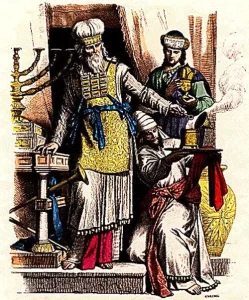
An image of the high priest Aaron wearing his gem studded breast plate.
It was not until the 17th century that it was suggested that people should wear the gemstone attributed to their birth month all year round. Up until that point people would aspire to own all twelve and change them every month.
The current birthstone list dates back to 1912 as a result of the National Association of Jewellers (America) trying to standardize the list. There have since been a number of changes and additions to this list and some months have several stones allocated to them; a main stone followed by a secondary or tertiary stone.
Birthstones however remain a fun, popular and colourful introduction to the world of gemstones. They appeal to audiences all around the world regardless of gender, age, nationality or religion and are said to carry secrets, attributes and lore that are unique to each gemstone. There are countless myths and legends about the many different powers and attributes that birthstones have and whether or not you believe these legends, it’s hard not to be drawn to discover which stone is yours and what this may reveal about you.
Discover what makes your birthstone a powerful statement of your finest qualities by finding out below which month is yours.
1) January: Garnet
January’s birthstone is garnet which not only comes in a deep reddish brown hue but many different beautiful colours from bright green to firey orange and a fabulous bright red. There are even garnets that change colour from blue to purple in different light. The legend behind a garnet is that in medieval times the stones were thought to cure depression and protect against bad dreams, almost like a dream catcher. Some believe the true value of the garnet birthstone is its power to bring the wearer good health, wealth and happiness.
2)February: Amethyst
February’s birthstone is amethyst, the purple variety of quartz that has captivated mankind for millennia. Its lilac to deep purple hues can be cut into many shapes and sizes and can be found in the collections of royal families throughout Europe and Asia. Wearing an amethyst is often considered as a symbol of personal empowerment and inner strength. The ancient Greeks associated the mineral with Bacchus, the god of wine. It was believed that wearing amethyst would keep the drinker sober. Perhaps the modern sentiment, that amethyst brings power to the wearer, derives from this sense of being clearheaded.
3) March: Aquamarine
March’s birthstone is aquamarine, the gorgeous blue to greenish blue variety of the mineral beryl. Its name is derived from two Latin words: aqua, meaning “water,” and marina, meaning “of the sea.” During the Middle Ages Europeans believed this gem gave its wearer wisdom and the ability to overcome evil and today it is also considered a symbol of unity.
4) April: Diamond
April’s birthstone is one of the most coveted birthstones of them all, due to their rarity and beauty. Romans believed that Cupid’s arrows were tipped with diamonds and the stones still very much remain a symbol of love, romance and commitment today. It is the hardest of all gemstones and some diamonds are more than three billion years old, which is probably the reason that they represent endurance. Please see November’s “Ask Annie” diamond blog for more info on these gorgeous gems.
5) May: Emerald
Emerald is the beautiful birthstone of May. The deep green beauty behind the stone is the perfect green hue to represent spring and renewal. No surprise it is therefore a symbol fertility and life, and the Romans dedicated this stone to Venus, the Goddess of love.
6) June: Pearl, Alexandrite and Moonstone
Pearls come in multiple shapes, sizes and colours. To find out more about all the different types of pearls please look at October’s “Ask Annie” blog. This birthstone has been associated with the moon and water, due to its appearance and origin, and also symbolises purity and love. Alexandrite is a very rare, expensive and beautiful stone which changes, from a strong blue-green by day to a purple “plum red” at night depending on its light. Alexandrite was appropriately named after Alexander II of Russia, who happened to have a birthday on the same day the gemstone was first unearthed.
Finally, Moonstone is renowned for its adularescence, the light that appears to billow across a gemstone, giving it a special glow and internal beauty. Moonstone is often associated with love, passion and fertility; it is believed to bring great strength to those who wear it.
7) July: Ruby
Ruby is a gemstone that is steeped in legend and lore, and is said to preserve physical and mental health, and prevent evil thoughts. Ruby is one of the world’s rarest and costliest gems and can command the highest price per carat of all the world’s jewels. No surprise that it is often referred to as the “Gem King”. It is the chromium within a ruby that is responsible for giving its distinctive crimson colour and fluorescent glow.
8) August: Peridot
Peridot’s birthstone, is called “Gem of the Sun” due to its beautiful green glow. It forms in lava deep in the earth’s crust and has also been found in meteorites. Peridot is said to attract wealth and drive away evil spirits.
9) September : Sapphire
Sapphires come in so many beautiful shades and colours from blue and purple to pink, yellow, orange and green. They have been used by royalty throughout history with Kings and Queens wearing them to protect against treachery. This stone is said to signify truth, sincerity and faithfulness.
10) October: Tourmaline and Opal
Opal is another stone that comes in a galaxy of kaleidoscopic colours and shades and is considered the most magical of gems, with no other gemstones matching it for its variety of electric colours. Europeans long maintained the opal to be a symbol of purity, hope and truth.
Tourmaline has recently become a birthstone for October. The name comes from the Sinhalese word toramalli, which means “stone with mixed colours”, because it often has multiple colours in one crystal. Very few gems match tourmaline’s dazzling array of colours. The different colours of tourmaline are thought to have their own healing properties. Black tourmaline is believed to protect the wearer and give a sense of self-confidence. Pink tourmaline embodies love and is associated with compassion and gentleness. Green tourmaline promotes courage, strength and stamina.
11) November: Citrine and Topaz
Citrine has a deep yellow colour and is said to guard its wearer from evil thoughts. This November birthstone is the transparent yellow to brownish orange variety of quartz, which has been used in jewellery for thousands of years. Citrine has been a popular gemstone since ancient times and has shared a history of mistaken identities with the other November birthstone, topaz. As a result, people thought that citrine had the same powers as topaz. They believed that citrine could soothe tempers and calm the wearer.
Topaz was believed to give the wearer strength and confidence and during the 1600s Europeans thought it could thwart magic spells and dispel anger. For centuries, many people in India have believed that topaz worn above the heart assures long life, beauty and intelligence. The variety of topaz hues include, colourless light blue, yellow, orange, pink, violet, brown and, very rarely, red.
12) December : Turquoise, Tanzanite and Zircon
December offers a flexibility of three birthstones with a myriad of colours.
Turquoise is a semi-translucent to opaque gem that ranges from blue to green and often has veins of matrix (remnants of the rock in which it formed) running through it. This December birthstone has been cherished for millennia. The pharaohs and other rulers of ancient Egypt adorned themselves with it and Chinese artisans carved it more than 3,000 years ago. Turquoise was thought to possess many beneficial powers, such as guaranteeing health and good fortune.
Tanzanite is a beautiful stone, often described as “velvety”, mostly because of its deep and saturated colour, which ranges from a pure rich blue to violet, with the blue considered most valuable. Tanzanite is a relative newcomer to the world of coloured stones, but it was one of the most exciting gem discoveries of the 20th century. It was eventually named tanzanite in honour of its country of origin.
Zircon is available in a myriad of colours from red and orange to yellow, brown and green. Colourless zircon is known for its brilliance and flashes of multicoloured light, called fire, which have resulted in centuries of confusion with diamond.

